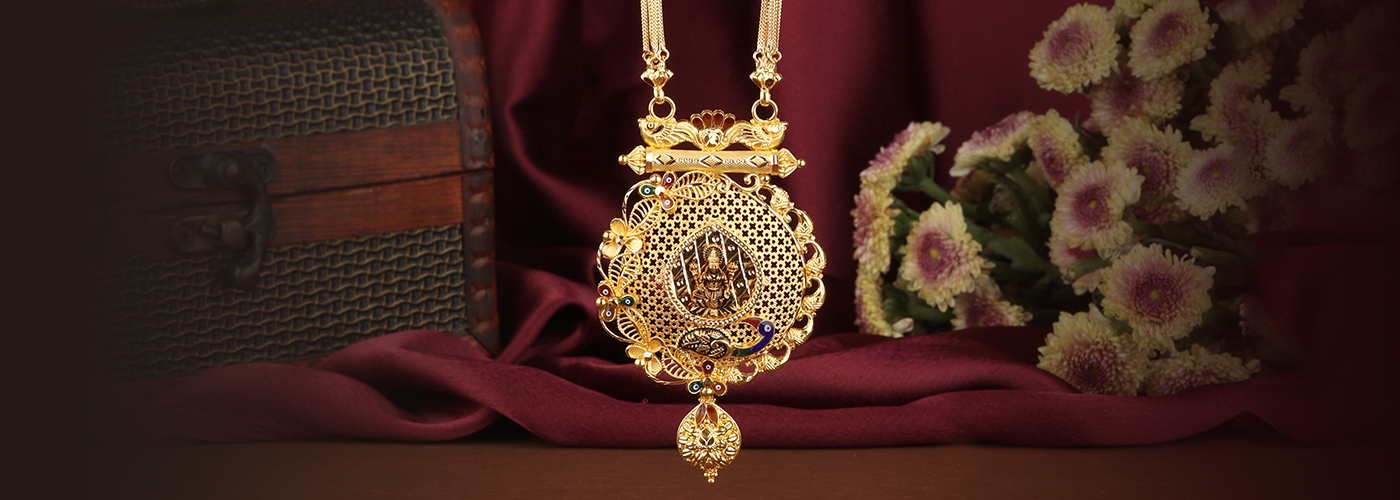Maharashtrian jewellery is a beautiful reflection of the state’s rich heritage, artistry, and deep-rooted cultural traditions. From the intricate patterns of Kolhapuri Saaj to the elegance of Thushi, each piece tells a story of devotion, legacy, and craftsmanship. With styles influenced by Maratha royalty, spiritual beliefs, and regional preferences, Maharashtrian jewellery is as diverse as it is timeless.
Let’s explore the various styles that make up this regal tradition and how they continue to captivate brides and jewellery lovers across generations.
1. Thushi: The Royal Choker of Maharashtra
The Thushi necklace is a classic choker-style ornament made from tightly arranged gold beads.
- Origin: Worn by Peshwa women as a mark of nobility.
- Design: Lightweight and adjustable, making it comfortable for long wear.
- Occasions: Ideal for weddings, Gudi Padwa, and festive ceremonies.
Style Tip: Pair with a Paithani saree and green bangles for a traditional bridal look.
2. Kolhapuri Saaj: A Necklace Full of Symbolism
The Kolhapuri Saaj is one of the most iconic pieces in Maharashtrian jewellery.
- Features: A string of 21 pendants, each with religious or nature-inspired symbolism.
- Significance: Represents blessings, protection, and prosperity.
- Cultural Roots: Originates from Kolhapur, known for intricate goldsmithing.
Heirloom Value: Often passed down from one generation to the next.
3. Nath: The Regal Nose Ring
The Maharashtrian Nath is instantly recognizable and an essential bridal ornament.
Types:
- Brahmani Nath – Adorned with pearls.
- Peshwai Nath – Larger and often embedded with stones.
Symbolism: Denotes marital status, prosperity, and traditional beauty.
Perfect For: Weddings, pujas, and festive occasions.
4. Tode & Patlya: Statement Bangles
Bangles are central to Maharashtrian culture, and Tode and Patlya are key traditional styles.
- Tode: Thick, cylindrical gold bangles with intricate carvings.
- Patlya: Flat, broader gold bangles with delicate patterns.
- Worn With: Green glass bangles, which symbolise fertility and new beginnings.
Tip: Wear them together for an authentic bridal look.
5. Jodvi: The Traditional Toe Rings
The Jodvi is a pair of silver toe rings given to the bride by her in-laws post-wedding.
- Cultural Role: Symbolises a woman’s transition into married life.
- Health Belief: Said to regulate energy and reproductive health.
Tradition Meets Purpose: Both spiritual and physiological significance.
6. Mangalsutra: The Sacred Symbol of Marriage
No Maharashtrian bridal look is complete without the Mangalsutra.
- Design: Black beads strung with two gold vatis (discs).
- Meaning: Protects the couple from evil and signifies eternal union.
- Modern Takes: Now available in sleek, daily-wear styles and diamond-studded variants.
7. Gold Lockets and Pendant Sets
Gold lockets and pendants are a more versatile form of Maharashtrian jewellery.
- Designs: Floral, deity-inspired, or personalised motifs.
- Wearability: Suitable for both traditional occasions and everyday elegance.
Diamond lockets are also popular for brides who want a sparkle of modern sophistication.
8. Gold Necklace Sets: The Statement Pieces
These grand pieces are worn for major events like weddings and festivals.
Styles:
- Peshwai Haar – Long necklace with regal motifs.
- Temple Jewellery – Inspired by deities and temple architecture.
Layering Tip: Combine with a Thushi or Kolhapuri Saaj for maximum impact.
Final Thoughts: A Culture Worn with Pride
Maharashtrian jewellery styles are a tribute to the state’s timeless artistry and cultural richness. Whether it’s the spiritual symbolism of the Mangalsutra, the heirloom value of the Kolhapuri Saaj, or the elegance of a Thushi, each piece is crafted not just to adorn but to tell a story.
Discover the complete range of authentic Maharashtrian jewellery at Waman Hari Pethe Sons. Embrace tradition with designs that reflect your roots and elevate every celebration.

